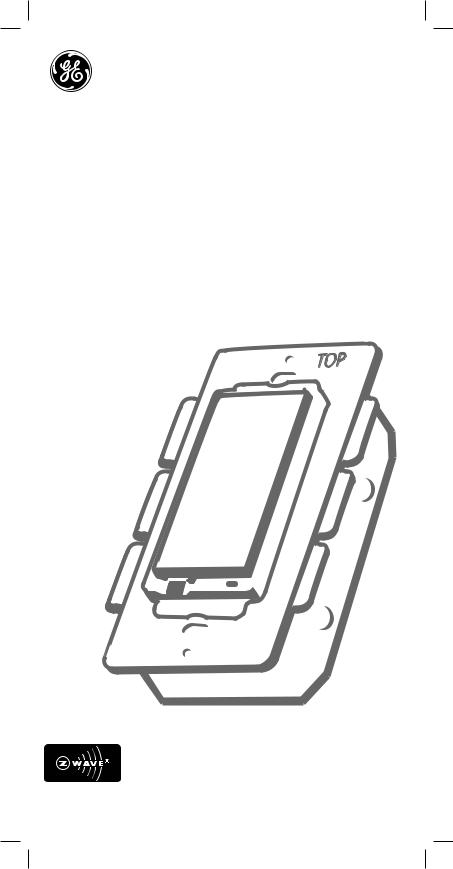GE 45609, 45614 User Manual

45609/45614
Z-Wave® Certified
Wireless Lighting Control
On/Off Relay Switch
and 3-Way Switch Kit
Control the On/Off status of permanently installed lighting, fans and more!
www.easyzwave.com |
©2009 Jasco |
Made in China |

Z-Wave® Certified
Wireless Lighting Control
On/Off Relay Switch
and 3-Way Switch Kit
Introduction
Thank you for your purchase of a GE Z-Wave® control device. Z-Wave technology is designed to automate lighting/home control and provide easy remote operation of all your Z-Wave enabled devices. The GE Z-Wave product family includes a variety of devices to control lighting in your home. It is up to you whether you want to control one room or your entire house and whether you want to do it all now or start with one room and add more over time.
This switch is one component of a Z-Wave® control system and is designed to work with all other Z-Wave enabled devices in a home control network. It will also act as a wireless repeater to insure that commands intended for another device in the network are received, thereby extending the range of the wireless controller. Z-Wave devices of other types and brands can be added to the system and will also act as range extenders if they support this function of repeating the signal received to other nodes in the system.
 CAUTION
CAUTION
This device is intended for installation in accordance with the National Electric Code and local regulations in the United
States, or the Canadian Electrical Code and local regulations in Canada. If you are unsure or uncomfortable about performing this installation consult a qualified electrician.
This switch is designed for use only with permanently installed fixtures. The device controlled by this Z-Wave switch must not exceed 600 watts (Incandescent); 15 Amps, 1800W (Resistive); or ½ HP (Motor).
NOT FOR USE WITH MEDICAL OR LIFE SUPPORT EQUIPMENT
Z-Wave enabled devices should never be used to supply power to or control the On/Off status of medical and/or life support equipment!
There are no user serviceable parts in this unit.
2

 WARNING
WARNING
RISK OF FIRE
RISK OF ELECTRICAL SHOCK
RISK OF BURNS
Controlling Appliances:
Exercise extreme caution when using Z-Wave devices to control appliances. Operation of the Z-Wave device may be in a different room than the controlled appliance, also an unintentional activation may occur if the wrong button on the remote is pressed. Z-Wave devices may automatically be powered on due to timed event programming. Depending upon the appliance, these unattended or unintentional operations could possibly result in a hazardous condition. For these reasons, we recommend the following:
1.Assign Z-Wave controlled appliances to device numbers 10
–18 on the GE remote. The likelihood of unintentionally turning on the appliance will be reduced significantly because the “Shift” button will need to be pressed before pressing device numbers 10-18.
2.Z-Wave devices controlling appliances should be removed from “All” control setting. Instructions on how to do this are included in the manual for your GE remote.
3.Do Not include Z-Wave devices in Groups or Scenes if they control appliances.
4.Do Not use Z-Wave devices to control electric heaters or any other appliances which may present a hazardous condition due to unattended or unintentional or automatic power on control.
5.Double check programs for accuracy before using them.
WIRELESS RANGE
This device complies with the Z-Wave standard of open-air, line of sight transmission distances of 65 feet. Actual performance in a home depends on the number of walls between the remote
controller and the destination device, the type of construction and the number of Z-Wave enabled devices installed in the control network. Most Z-Wave devices act as signal repeaters and multiple devices result in more possible transmission routes which helps eliminate “RF dead-spots”.
3

Things to consider regarding RF range:
•Each wall or obstacle (i.e.: refrigerator, big screen TV, etc.) between the remote or Z-Wave device and the destination device will reduce the maximum range by approximately 25-30%.
•Brick, tile or concrete walls block more of the RF signal than walls made of wooden studs and plasterboard (drywall).
•Wall mounted Z-Wave devices installed in metal junction boxes may suffer a significant loss of range (approximately 20%) since the metal box blocks a large part of the RF signal.
Effects of Home Construction on Wireless Range Between Z-Wave Enabled Devices
Note: The distances shown in the table below are typical examples. Actual performance in your home will vary.
From the Remote (or repeating Z-Wave module) to destination device:
Type of |
|
Wood Frame with |
Brick, Tile or |
|||
Construction |
|
Drywall |
|
Concrete |
|
|
|
|
|
|
|
|
|
|
|
Plastic |
Metal |
Plastic |
Metal |
|
|
|
J-Boxes* |
J-Boxes |
J-Boxes* |
J-Boxes |
|
Number of |
0** |
100’ |
80’ |
100’ |
80’ |
|
Walls or |
1 |
70’ |
56’ |
60’ |
48’ |
|
Obstacles |
||||||
2 |
49’ |
39’ |
36’ |
29’ |
||
|
||||||
|
3 |
34’ |
27’ |
21’ |
17’ |
|
|
|
|
|
|
|
|
* For Plug-in Modules or In-Wall Devices Installed in Plastic Junction Boxes
** Line of Sight / no obstructions
Please Note: Z-Wave home control networks are designed to work properly alongside 802.11 wireless computer networks, Bluetooth and other 2.4GHz or 5.8GHz devices. Some baby cams, wireless video devices and older cordless phones using the 900MHz frequency range may cause interference and limit Z-Wave functionality. Many 900MHz products have a switch to select channel “A” or “B”. You may find that one of these channels will cause less interference than the other.
IMPORTANT NOTE ABOUT 3-WAY CIRCUITS
The term “3-way circuit” refers to a circuit with two switches and one load (light) like you find at the top and bottom of a stairway. There are many ways to physically wire a 3-way circuit and it is important to understand how the circuit you wish to upgrade to Z-Wave control is wired. Below is a description of a typical 3-way circuit.
4
